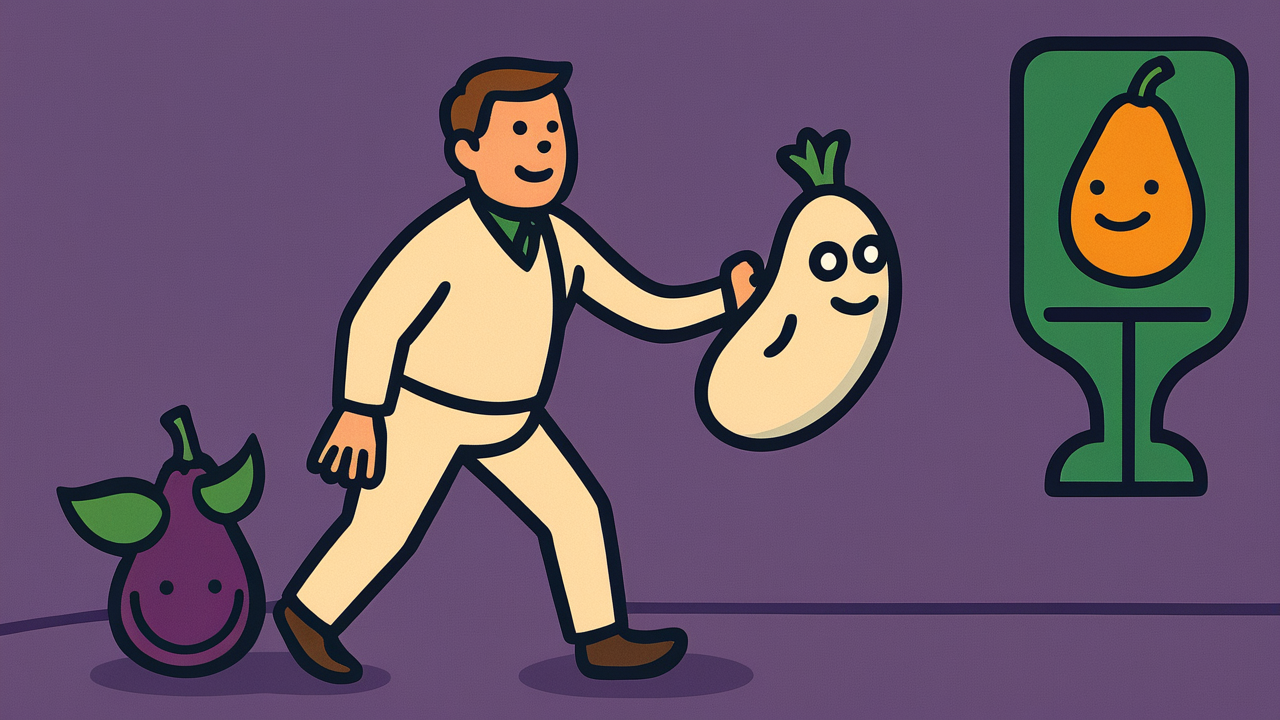How to Read “茄子を踏んで蛙と思う”
Nasu wo funde kaeru to omou
Meaning of “茄子を踏んで蛙と思う”
“Step on eggplant and think frog” represents making incorrect judgments about things without accurate assessment, leading to wrong perceptions due to assumptions and preconceptions.
This proverb depicts a situation where someone steps on something underfoot in the dark and, judging only by the sensation, mistakes it for something completely different. From the specific scenario of mistaking the soft feeling of stepping on an eggplant for stepping on a living frog, it teaches us about the ambiguity of human perception and the danger of hasty judgments.
This expression is used when someone jumps to conclusions without sufficient confirmation or draws conclusions based only on superficial information. It’s also used for self-reflection when one has failed due to assumptions. Even today, this lesson is very relevant in situations where people take social media information at face value or judge others based solely on first impressions. It conveys through familiar experiences that accurate judgment requires thorough observation and confirmation.
Origin and Etymology
I researched the origins of this proverb, but I was unable to find any commonly known established theory or documented records. While the origin is unclear, judging from the structure of the phrase, it’s possible that this expression is rooted in Japanese rural culture.
Eggplants have been cultivated in Japan since ancient times and were familiar crops harvested especially from summer to autumn. Meanwhile, frogs were creatures commonly seen in rice paddies and fields, making them familiar to people engaged in agricultural work.
The background for this expression’s creation likely involved experiences during nighttime or in dimly lit places. This metaphor may have emerged from the similarity between the sensation of stepping on a fallen eggplant in a field and the feeling of stepping on a frog.
Looking at how the phrase is constructed, it has a structure that expresses broader life lessons from specific situations based on actual experiences. This is a characteristic common to many Japanese proverbs, reflecting the Japanese sensibility of trying to find life wisdom from small incidents in daily life.
Usage Examples
- I made another hasty mistake like “Step on eggplant and think frog”
- His story apparently began with a misunderstanding like “Step on eggplant and think frog”
Modern Interpretation
In modern society, the problem of “misperception due to assumptions” that this proverb indicates has become more serious. In our information society, we encounter vast amounts of information daily, but we’re placed in situations where we must judge most of it instantly.
On social media and the internet, it frequently happens that people judge content based only on headlines or titles, or feel they understand the whole picture from just partial information. This is exactly the situation of “Step on eggplant and think frog.” The spread of fake news and inflammatory incidents based on misunderstandings can be said to be modern versions of this phenomenon.
Moreover, with the advancement of AI technology making image and audio manipulation easy, we’ve entered an era where truth cannot be determined by appearance or sound alone. Technologies like deepfakes can be said to be techniques that “make us think eggplant is frog” by deceiving our senses.
On the other hand, verification methods have also become abundant in modern times. By checking multiple information sources or using fact-checking sites, we can prevent misperceptions due to assumptions. This proverb’s teaching has taken on contemporary meaning in explaining the importance of information literacy.
Precisely because we live in a modern society that values speed, this proverb reminds us of the importance of stopping to confirm things.
When AI Hears This
“Stepping on an eggplant and thinking it’s a frog” perfectly illustrates confirmation bias in action. Confirmation bias is a cognitive distortion where we unconsciously seek out only information that supports our preconceptions—a phenomenon proven through experiments by British psychologist Peter Wason in the 1960s.
What’s fascinating about this proverb is how it captures the moment when, based on limited tactile information, our brain jumps to the conclusion “it’s a frog” and immediately switches into evidence-hunting mode to support that hypothesis. The slimy, elastic surface of an eggplant does indeed resemble the skin texture of a frog, so once we’re convinced it’s a “frog,” we become hyper-aware of only those similarities.
Modern research shows that for processing efficiency, the human brain makes judgments within about 0.1 seconds of a first impression, then unconsciously prioritizes information that justifies that initial judgment. This is exactly what happens when our attention fixates on the “frog-like” qualities—the softness and moisture of the eggplant—while we tend to overlook contradictory evidence like differences in shape or size.
It’s remarkable that people in the Edo period managed to identify cognitive mechanisms that modern science has only recently explained, distilling their observations into such a concise proverb. This suggests that confirmation bias is a universal human trait that transcends culture and era.
Lessons for Today
What this proverb teaches us today is “the importance of confirmation” and “the value of maintaining humility.” Precisely because we live in an era overflowing with information, it’s important to develop the habit of stopping and asking ourselves, “Is this really true?”
The same applies to relationships with people in daily life. Don’t you sometimes determine someone’s feelings by looking at only part of their expression or words? If you listen more deeply, you often find completely different circumstances.
This proverb also teaches us not to fear failure too much. Mistaking an eggplant for a frog is a natural, human reaction. What’s important is honestly acknowledging mistakes when you realize them and maintaining an attitude of being more careful in future judgments.
To apply this in modern society, start by developing the habit of taking a breath when receiving information and asking, “Is this true?” and “Are there other ways to look at this?” Your judgment will surely become more reliable. You don’t need to be perfect. Having a humble heart that continues to learn is sufficient.



Comments